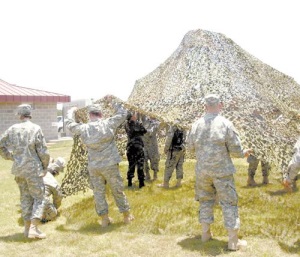Standing guard
Candace Cooksey Fulton - Brownwood Bulletin
2008/06/01
 Guard members rehearse setting up a “shade structure.” The camo netting significantly cools an area even in the hottest sun allowing guard members to set up a command post or temporary office in even the most barren terrains.
Guard members rehearse setting up a “shade structure.” The camo netting significantly cools an area even in the hottest sun allowing guard members to set up a command post or temporary office in even the most barren terrains.
They are the Texas State Guard, a force bigger than just about anything else among Texas’ bragging rights.
Thirteen hundred strong, and working under the mantra of “Texans serving Texas,” the state guard is the go-to force for hurricanes or disasters. The guard’s abilities range from setting up and maintaining communications in a crisis center, to administering emergency medical care and treatment; to evacuation assistance and shelter set up. Whatever the nature of the disaster, be it flood, fire or tornado, plane crash or terrorist attack, the state guard’s purpose is to stabilize in the aftermath.
In a rotation of three four-day training sessions held recently, the majority of the force has been at Camp Bowie, which, by general agreement seems to be an ideal place for the troops to gather and train. “Brownwood has good weather, good terrain and good air space,” said Col. Paul Tressa, retired military, who joined the guard about two years ago. “Brownwood’s good to the guard. People here seem really supportive and we enjoy it. At the same time, we’re making a fairly significant impact in town.”.
The last of the three four-day training sessions, scheduled to end Monday, has been attended by about 260 men and women. Though recent legislation has allowed the State Guard members to be paid about $100 for their four days, the money won’t cover the gas for the round-trip travel for the majority. Besides the travel expense, members buy their own uniforms, and in the event they get a call, they’ll need to supply their own gear and provisions to go wherever, for however long.
The Texas State Guard is one of three branches of the military forces of the state of Texas, all of which report to the Texas Adjutant General. Army and Air Guard or the other two branches. Unlike the Texas Army National Guard, the state guard cannot be federalized.
“We are the governor’s force, that he knows he can call on,” explained Capt. J. Michael Spraggins.
Call on for . . . ?
The list is extensive. The state guard assists local authorities in state and local emergencies; shelter management; medical services; volunteer coordination; legal support; communications; and chaplain services. And Spraggins said, if the list is not growing, it is at least expanding.
Certain chores that might have once fallen under the Army National Guard’s umbrella are getting picked up by the state force.
“With National Guard people deployed, we’re asked to pick up some of the slack at home,” Spraggins said.
Or as another for instance, when a problem arose distributing rabies prevention pellets for foxes and wolves in the wild, the Texas State Guard was able to help facilitate the distribution.
Guard members range in age from 18 to 70, and in fact among the group training this weekend, there’s a grandfather/granddaughter combination. Most members have day jobs. Spraggins is a banker, but there are CPAs, doctors, lawyers, police officers, nurses and business people in the fold.
“Some have been in the military, and they’re just not ready to give up the uniform,” said Stressa. “They like it, they like the social atmosphere and the military way of life.”
“Some are looking for some excitement, a not-necessarily ordinary experience and can’t or don’t feel like they can commit to the military armed forces because of family,” added Spraggins.
“And there are those, who know they can do something, who want to do something, who aren’t ready to retire, but possibly could retire. There are those, Texans, who want to serve, and see the state guard as a way to serve Texas.”